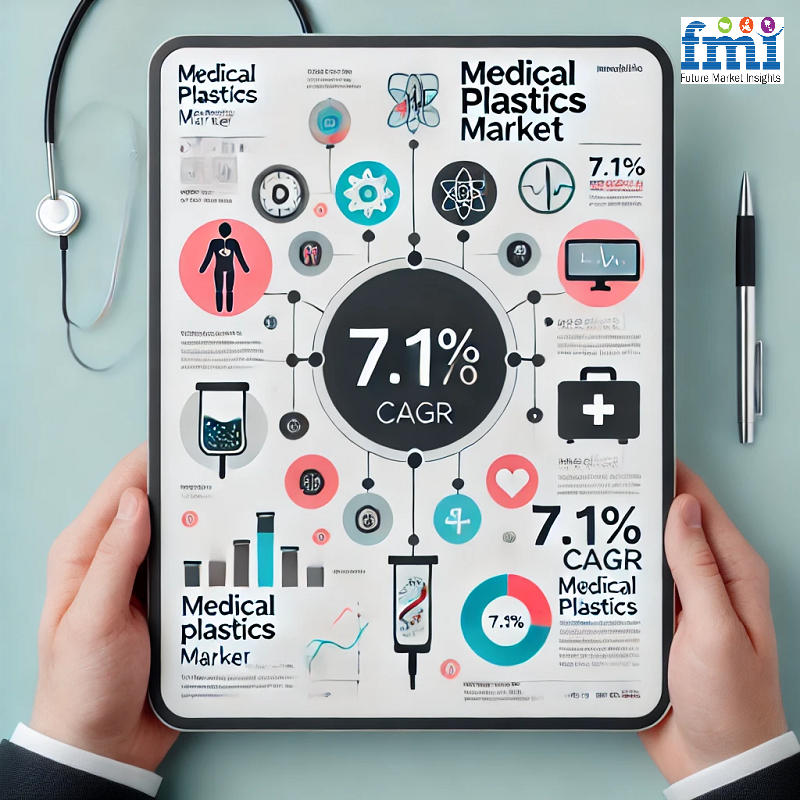The global Medical Plastics Market is projected to grow from USD 17,561.6 million in 2024 to USD 34,553.9 million by 2034, at a robust CAGR of 7.1% during the forecast period, driven by increasing demand for advanced medical devices, growing healthcare infrastructure, and sustainability concerns.
NEWARK, Del, Oct. 17, 2024 (GLOBE NEWSWIRE) — The Medical Plastics Market is on a growth trajectory, fueled by advancements in healthcare technologies and increasing adoption of medical devices that require specialized plastics for their production. Medical plastics are used in a wide range of applications, including surgical instruments, catheters, syringes, prosthetics, and medical packaging. Their ability to provide strength, flexibility, and biocompatibility makes them indispensable in the healthcare industry.
In 2024, the market size for medical plastics is projected to be USD 17,561.6 million, with the market expected to nearly double by 2034, reaching USD 34,553.9 million. This growth is primarily driven by the rising demand for disposable medical products and the increasing need for advanced medical devices in both developed and developing regions. The shift toward minimally invasive surgeries and an aging global population further contribute to the market’s expansion.
The introduction of biocompatible and biodegradable plastics has opened new opportunities for the medical plastics industry, especially in addressing sustainability concerns. As healthcare regulations become more stringent, manufacturers are focusing on producing materials that meet safety standards while reducing environmental impact. Medical plastics are also gaining traction due to their cost-effectiveness, lightweight properties, and ability to be easily sterilized.
In the wake of the COVID-19 pandemic, the demand for personal protective equipment (PPE), medical devices, and diagnostic tools surged, further highlighting the critical role of medical plastics. The market is expected to continue expanding as healthcare systems evolve and the need for efficient, safe, and sustainable medical solutions grows.
Drivers and Opportunities
The primary driver for the Medical Plastics Market is the increasing demand for disposable medical products, such as syringes, gloves, catheters, and surgical instruments. These products require materials that are cost-effective, safe, and easy to sterilize, making medical plastics the ideal choice. Additionally, the rising prevalence of chronic diseases and the growing elderly population are increasing the demand for advanced medical devices and prosthetics, further boosting the market.
Opportunities are also emerging from the development of biodegradable and biocompatible plastics, which address the growing concerns around medical waste and environmental sustainability. With healthcare regulations becoming more stringent, manufacturers are focusing on developing materials that meet both safety and environmental standards.
The expansion of healthcare infrastructure in emerging markets presents additional growth opportunities for the medical plastics industry. As these regions increase their healthcare spending, the demand for medical devices and packaging solutions made from medical-grade plastics is expected to rise.
“The increasing focus on patient safety, coupled with the rising demand for high-performance medical devices, is driving the growth of the Medical Plastics Market. Innovations in biocompatible and sustainable materials are expected to provide a significant boost to the market, as healthcare providers prioritize both quality and environmental impact,” Nikhil Kaitwade, Associate Vice President at Future Market Insights (FMI)
Key Takeaways from Market Study
- The Medical Plastics Market is expected to grow at a CAGR of 7.1% from 2024 to 2034.
- The market size is projected to increase from USD 17,561.6 million in 2024 to USD 34,553.9 million by 2034.
- Rising demand for disposable medical products and advanced medical devices is driving market growth.
- The development of biodegradable and biocompatible plastics is creating new opportunities in the market.
- The COVID-19 pandemic has highlighted the importance of medical plastics in the production of PPE and diagnostic tools.
Component Insights
Medical plastics are available in various forms, each with its own set of applications in the healthcare industry. These include:
- Polyvinyl Chloride (PVC): Widely used in medical tubing, blood bags, and catheters due to its flexibility and durability.
- Polypropylene (PP): Commonly used in syringes, medical containers, and packaging materials for its lightweight and chemical resistance properties.
- Polycarbonate (PC): Utilized in medical devices such as oxygenators, hemodialysis filters, and surgical instruments for its strength and transparency.
- Polyethylene (PE): Known for its use in prosthetics, implants, and medical containers due to its biocompatibility and high strength-to-weight ratio.
With the growing focus on sustainability, biocompatible and biodegradable plastics are gaining popularity, particularly in applications where medical waste reduction is a priority. These materials are expected to play a crucial role in the future of medical device manufacturing.
Explore the Full Report for Detailed Insights! https://www.futuremarketinsights.com/reports/medical-plastics-market
Market’s Prime Determinants of Growth, Trends, and Opportunities
The growth of the Medical Plastics Market is driven by several key factors, including the rising demand for medical devices and disposable healthcare products, the increasing adoption of minimally invasive surgeries, and advancements in medical technologies. As healthcare providers seek more efficient and safe solutions, the demand for medical plastics is expected to increase.
Key trends include the shift toward biocompatible and biodegradable plastics, which address the growing concerns around medical waste and sustainability. Additionally, technological innovations in plastic manufacturing are enabling the production of lighter, stronger, and more durable medical devices.
Opportunities exist in the expansion of healthcare infrastructure in emerging markets, where the demand for medical plastics is rising rapidly due to increased healthcare spending and the growing need for advanced medical devices.

Key Companies & Market Share Insights
Leading companies in the Medical Plastics Market include:
- Celanese Corporation
- Trinseo PLC
- Ensinger Group
- BASF SE
- The Dow Chemical Company
- Saudi Basic Industries Corp (SABIC)
- DuPont de Nemours, Inc.
- Arkema Group
- Evonik Industries
- Eastman Chemical Company
- LyondellBasell Industries N.V.
- Hanwha Group
- Covestro AG
- Solvay SA
- EMCO Industrial Plastic Inc.
- The Lubrizol Corporation
- Trelleborg Group
- Teknor Apex
- Spartech LLC
- Raumedic AG
These companies are focusing on expanding their product portfolios by developing advanced medical-grade plastics that meet the evolving needs of the healthcare industry. Key strategies include research and development investments, partnerships, and acquisitions aimed at enhancing their market positions.
Growth Drivers
- Rising Demand for Disposable Medical Products: The need for cost-effective and safe disposable products, such as syringes, gloves, and catheters, is driving the demand for medical plastics.
- Advancements in Medical Device Technologies: Innovations in medical devices, including minimally invasive surgical tools and prosthetics, are increasing the use of high-performance plastics in healthcare.
- Shift Toward Biodegradable and Biocompatible Plastics: The development of eco-friendly plastics is addressing sustainability concerns and reducing the environmental impact of medical waste.
- Expansion of Healthcare Infrastructure in Emerging Markets: Growing healthcare spending in developing regions is boosting the demand for medical devices and packaging solutions made from medical plastics.
Key Segments of the Medical Plastics Industry
By Plastic Type:
Plastic types included in the study are Polyvinyl Chloride (PVC), Thermoplastic Elastomer (TPE), Polyethylene (PE), Polycarbonate (PC), Polypropylene (PP), Polyethylene Terephthalate (PET), Polyamides, Thermoplastic Polyurethane (TPU), Polymethyl Methacrylate, Acrylonitrile Butadiene Styrene (ABS), and Silicone Rubber.
Thermoplastic Elastomer (TPE) is further segmented into Thermoplastic Elastomer Vulcanizates (TPE-V) and Thermoplastic Elastomer Styrenics (TPE-S). Silicone Rubber is categorized into Liquid Silicone Rubber, High Consistency Rubber, Room Temperature Vulcanizing (RTV) Silicone, Silicone Adhesives, and others.
By End Use:
End-use segments included in the study are medical parts and components, tubing, film and bags, surgical tools, and medical cables and connectors. Medical parts & components encompass dropper bulbs, drip chambers, gaskets and stoppers, orthopedics, blood collection chambers, medical containers, and others.
Tubing covers catheter tubing, drug delivery, gas supply, peristaltic pump, oxygen tubing, blood transport & delivery, and others. Film and Bags include biopharmaceutical storage, saline bags, waste bags, and others. Surgical Tools consist of scalpels, forceps, scissors, and others. Medical cables and connectors are segmented into diagnostic equipment, prosthetics, and others.
By Region:
Key countries of North America, Latin America, Western Europe, Eastern Europe, East Asia, South Asia, the Middle East, and Africa (MEA), have been covered in the report.
Old Source: Medical Plastics Market to Hit US$ 106.23 Billion by 2032 | Future Market Insights, Inc.
Russian Translation –
Рынок медицинских пластиков находится на траектории роста, чему способствуют достижения в области медицинских технологий и растущее внедрение медицинских устройств, для производства которых требуются специализированные пластики. Медицинские пластики используются в широком спектре применений, включая хирургические инструменты, катетеры, шприцы, протезы и медицинскую упаковку. Их способность обеспечивать прочность, гибкость и биосовместимость делает их незаменимыми в отрасли здравоохранения.
Прогнозируется, что в 2024 году объем рынка медицинских пластиков составит 17 561,6 млн долларов США, а к 2034 году рынок почти удвоится, достигнув 34 553,9 млн долларов США. Этот рост в первую очередь обусловлен растущим спросом на одноразовые медицинские изделия и растущей потребностью в современных медицинских устройствах как в развитых, так и в развивающихся регионах. Переход к малоинвазивным операциям и старение населения мира еще больше способствуют расширению рынка.
Внедрение биосовместимых и биоразлагаемых пластиков открыло новые возможности для индустрии медицинских пластиков, особенно в решении проблем устойчивого развития. По мере ужесточения правил здравоохранения производители сосредотачиваются на производстве материалов, которые соответствуют стандартам безопасности и при этом снижают воздействие на окружающую среду. Медицинские пластмассы также набирают обороты благодаря своей экономической эффективности, легкости и возможности легкой стерилизации.
Вследствие пандемии COVID-19 резко возрос спрос на средства индивидуальной защиты (СИЗ), медицинские приборы и диагностические инструменты, что еще больше подчеркивает важную роль медицинских пластмасс. Ожидается, что рынок продолжит расширяться по мере развития систем здравоохранения и роста потребности в эффективных, безопасных и устойчивых медицинских решениях.
Движущие силы и возможности
Основной движущей силой рынка медицинских пластмасс является растущий спрос на одноразовые медицинские изделия, такие как шприцы, перчатки, катетеры и хирургические инструменты. Для этих изделий требуются материалы, которые являются экономически эффективными, безопасными и легко стерилизуются, что делает медицинские пластмассы идеальным выбором. Кроме того, растущая распространенность хронических заболеваний и растущее население пожилого возраста увеличивают спрос на современные медицинские приборы и протезы, что еще больше стимулирует рынок.
Возможности также появляются в результате разработки биоразлагаемых и биосовместимых пластиков, которые решают растущие проблемы, связанные с медицинскими отходами и экологической устойчивостью. Поскольку правила здравоохранения становятся все более строгими, производители сосредотачиваются на разработке материалов, которые соответствуют как стандартам безопасности, так и экологическим стандартам.
Расширение инфраструктуры здравоохранения на развивающихся рынках представляет дополнительные возможности для роста для индустрии медицинских пластиков. Поскольку эти регионы увеличивают свои расходы на здравоохранение, ожидается, что спрос на медицинские устройства и упаковочные решения, изготовленные из пластика медицинского класса, будет расти.
«Растущее внимание к безопасности пациентов в сочетании с растущим спросом на высокопроизводительные медицинские устройства являются движущей силой роста рынка медицинских пластиков. Ожидается, что инновации в области биосовместимых и устойчивых материалов обеспечат значительный рост рынка, поскольку поставщики медицинских услуг уделяют первостепенное внимание как качеству, так и воздействию на окружающую среду», — Нихил Кайтваде, заместитель вице-президента Future Market Insights (FMI)
Основные выводы из исследования рынка
• Ожидается, что рынок медицинских пластиков будет расти в среднем на 7,1% в период с 2024 по 2034 год.
• Прогнозируется, что размер рынка увеличится с 17 561,6 млн долларов США в 2024 году до 34 553,9 млн долларов США к 2034 году.
• Растущий спрос на одноразовые медицинские изделия и современные медицинские устройства стимулирует рост рынка.
• Разработка биоразлагаемых и биосовместимых пластиков создает новые возможности на рынке.
• Пандемия COVID-19 подчеркнула важность медицинских пластиков в производстве СИЗ и диагностических инструментов.
Component Insights
Медицинские пластики доступны в различных формах, каждая из которых имеет свой собственный набор применений в отрасли здравоохранения. К ним относятся:
• Поливинилхлорид (ПВХ): широко используется в медицинских трубках, пакетах для крови и катетерах благодаря своей гибкости и долговечности.
• Полипропилен (ПП): обычно используется в шприцах, медицинских контейнерах и упаковочных материалах благодаря своей легкости и химической стойкости.
• Поликарбонат (ПК): используется в медицинских устройствах, таких как оксигенаторы, фильтры для гемодиализа и хирургические инструменты, благодаря своей прочности и прозрачности.
• Полиэтилен (ПЭ): известен своим использованием в протезах, имплантатах и медицинских контейнерах благодаря своей биосовместимости и высокому соотношению прочности к весу.
С растущим вниманием к устойчивости биосовместимые и биоразлагаемые пластики набирают популярность, особенно в тех областях, где сокращение медицинских отходов является приоритетом. Ожидается, что эти материалы будут играть решающую роль в будущем производства медицинских устройств.
Основные факторы, определяющие рост, тенденции и возможности рынка
Рост рынка медицинских пластиков обусловлен несколькими ключевыми факторами, включая растущий спрос на медицинские устройства и одноразовые медицинские изделия, растущее внедрение малоинвазивных операций и достижения в области медицинских технологий. Поскольку поставщики медицинских услуг ищут более эффективные и безопасные решения, ожидается, что спрос на медицинские пластики будет расти.
К основным тенденциям относится переход к биосовместимым и биоразлагаемым пластикам, которые решают растущие проблемы, связанные с медицинскими отходами и устойчивым развитием. Кроме того, технологические инновации в производстве пластика позволяют производить более легкие, прочные и долговечные медицинские устройства.
Существуют возможности расширения инфраструктуры здравоохранения на развивающихся рынках, где спрос на медицинские пластики быстро растет из-за увеличения расходов на здравоохранение и растущей потребности в современных медицинских устройствах.
Ключевые компании и анализ доли рынка
Ведущие компании на рынке медицинских пластиков включают:
• Celanese Corporation
• Trinseo PLC
• Ensinger Group
• BASF SE
• The Dow Chemical Company
• Saudi Basic Industries Corp (SABIC)
• DuPont de Nemours, Inc.
• Arkema Group
• Evonik Industries
• Eastman Chemical Company
• LyondellBasell Industries N.V.
• Hanwha Group
• Covestro AG
• Solvay SA
• EMCO Industrial Plastic Inc.
• The Lubrizol Corporation
• Trelleborg Group
• Teknor Apex
• Spartech LLC
• Raumedic AG
Эти компании сосредоточены на расширении своего ассортимента продукции путем разработки современных медицинских пластиков, которые отвечают меняющимся потребностям отрасли здравоохранения. Основные стратегии включают инвестиции в исследования и разработки, партнерства и приобретения, направленные на укрепление их позиций на рынке.
Драйверы роста
• Растущий спрос на одноразовые медицинские изделия: потребность в экономически эффективных и безопасных одноразовых изделиях, таких как шприцы, перчатки и катетеры, стимулирует спрос на медицинские пластмассы.
• Достижения в технологиях медицинских устройств: инновации в медицинских устройствах, включая минимально инвазивные хирургические инструменты и протезы, увеличивают использование высокопроизводительных пластмасс в здравоохранении.
• Переход к биоразлагаемым и биосовместимым пластмассам: разработка экологически чистых пластмасс решает проблемы устойчивости и снижает воздействие медицинских отходов на окружающую среду.
• Расширение инфраструктуры здравоохранения на развивающихся рынках: растущие расходы на здравоохранение в развивающихся регионах повышают спрос на медицинские устройства и упаковочные решения из медицинских пластмасс.
Ключевые сегменты медицинской пластиковой промышленности
По типу пластика:
В исследование включены следующие типы пластика: поливинилхлорид (ПВХ), термопластичный эластомер (ТПЭ), полиэтилен (ПЭ), поликарбонат (ПК), полипропилен (ПП), полиэтилентерефталат (ПЭТ), полиамиды, термопластичный полиуретан (ТПУ), полиметилметакрилат, акрилонитрилбутадиенстирол (АБС) и силиконовый каучук.
Термопластичный эластомер (ТПЭ) далее сегментируется на термопластичные эластомерные вулканизаты (ТПЭ-В) и термопластичные эластомерные стирены (ТПЭ-С). Силиконовый каучук подразделяется на жидкий силиконовый каучук, каучук высокой консистенции, вулканизирующийся при комнатной температуре (RTV) силикон, силиконовые клеи и другие.
По конечному использованию:
Сегменты конечного использования, включенные в исследование, включают медицинские детали и компоненты, трубки, пленки и пакеты, хирургические инструменты, а также медицинские кабели и разъемы. Медицинские детали и компоненты включают капельницы, капельницы, прокладки и пробки, ортопедические изделия, камеры для сбора крови, медицинские контейнеры и другие.
Трубки охватывают катетерные трубки, доставку лекарств, подачу газа, перистальтический насос, кислородные трубки, транспортировку и доставку крови и другие. Пленка и пакеты включают биофармацевтическое хранилище, пакеты для физиологического раствора, пакеты для отходов и другие. Хирургические инструменты включают скальпели, щипцы, ножницы и другие. Медицинские кабели и разъемы сегментированы на диагностическое оборудование, протезы и другие.
По регионам:
В отчете рассматриваются ключевые страны Северной Америки, Латинской Америки, Западной Европы, Восточной Европы, Восточной Азии, Южной Азии, Ближнего Востока и Африки (MEA).
Authored by:
Nikhil Kaitwade (Associate Vice President at Future Market Insights, Inc.) has over a decade of experience in market research and business consulting. He has successfully delivered 1500+ client assignments, predominantly in Automotive, Chemicals, Industrial Equipment, Oil & Gas, and Service industries.
His core competency circles around developing research methodology, creating a unique analysis framework, statistical data models for pricing analysis, competition mapping, and market feasibility analysis. His expertise also extends wide and beyond analysis, advising clients on identifying growth potential in established and niche market segments, investment/divestment decisions, and market entry decision-making.
Nikhil holds an MBA degree in Marketing and IT and a Graduate in Mechanical Engineering. Nikhil has authored several publications and quoted in journals like EMS Now, EPR Magazine, and EE Times.
Explore FMI’s Extensive Coverage in the Chemicals & Materials Domain:
The global plastic compounding market is expected to reach a market valuation of USD 69.919 billion by the end of 2023, accelerating with a CAGR of 8.3% from 2023 to 2033.
The bio-plastic market size is projected to be worth USD 96.6 billion in 2023. The market is likely to reach USD 1,353.3 billion by 2033.
The global plastic compounding market is expected to reach a market valuation of USD 69.919 billion by the end of 2023, accelerating with a CAGR of 8.3% from 2023 to 2033.
From 2023 to 2033, the wood plastic composite (WPC) floorings market is to register a 7.0% CAGR, reaching USD 4.19 billion by 2033.
The glass fiber reinforced plastic (GFRP) composites market is predicted to capture a valuation of USD 18.54 billion in 2023, and is rising to USD 41.53 billion by 2033.
The global fiberglass market is estimated to register a remarkable value of USD 11,356.30 million by 2024.
The global biophotonics market is expected to record a CAGR of 11.3% from 2023 to 2033. In 2023, the market size is projected to reach a valuation of USD 54,320.0 million.
The global powder injection molding market is projected to register a healthy growth pace with a CAGR of 9.3% from 2022-2032.
The global polymer coated fabrics market size is valued at around USD 21,791.30 million in 2023 and is anticipated to progress at a healthy CAGR of 5.1% from 2023 to 2033.
According to the latest market survey conducted by Future Market Insights, the global Polymer Emulsion market is relishing a market valuation of USD 23,867.2 Million in 2022, and all are set to expand with a CAGR of 6.1% during the 2022-2032 period.
About Future Market Insights (FMI)
Future Market Insights, Inc. (ESOMAR certified, recipient of the Stevie Award, and a member of the Greater New York Chamber of Commerce) offers profound insights into the driving factors that are boosting demand in the market. FMI stands as the leading global provider of market intelligence, advisory services, consulting, and events for the Packaging, Food and Beverage, Consumer Technology, Healthcare, Industrial, and Chemicals markets. With a vast team of over 400 analysts worldwide, FMI provides global, regional, and local expertise on diverse domains and industry trends across more than 110 countries.
Join us as we commemorate 10 years of delivering trusted market insights. Reflecting on a decade of achievements, we continue to lead with integrity, innovation, and expertise.
Contact Us:
Future Market Insights Inc.
Christiana Corporate, 200 Continental Drive,
Suite 401, Newark, Delaware – 19713, USA
T: +1-347-918-3531
For Sales Enquiries: [email protected]
Website: https://www.futuremarketinsights.com
LinkedIn| Twitter| Blogs | YouTube

Legal Disclaimer:
EIN Presswire provides this news content “as is” without warranty of any kind. We do not accept any responsibility or liability
for the accuracy, content, images, videos, licenses, completeness, legality, or reliability of the information contained in this
article. If you have any complaints or copyright issues related to this article, kindly contact the author above.
![]()
Originally published at https://www.einpresswire.com/article/752558192/rising-demand-for-biocompatible-and-disposable-medical-products-boosts-medical-plastics-market-to-usd-34-553-9-million-by-2034-study-by-future




